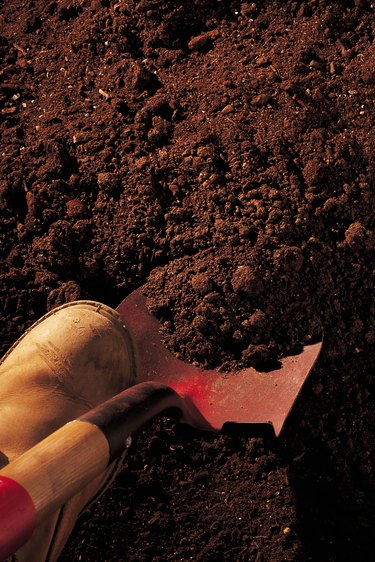Things You'll Need
Spade
Round point shovel
Bypass pruners
Garden hose
Organic soil amendments
Bark chip mulch
10-10-10 water-soluble fertilizer

Nandina domestica, commonly called heavenly bamboo, is a perennial shrub that grows in U.S. Department of Agriculture plant hardiness zones 6 through 9. The plant has evergreen or semi-evergreen leaves atop slender stalks. The stalks multiply quickly, forming large clumps up to 4 feet wide that can be invasive. You can transplant an existing plant, if needed, to accommodate the plant's size and provide full sun or partial shade. Take the opportunity to divide a crowded plant at the time of transplanting -- plant the divisions about 4 feet apart to create a mass of heavenly bamboo.
Step 1
Cut a circle around the heavenly bamboo plant that is about 8 inches deep and about 6 to 8 inches out from the stalks around the heavenly bamboo's perimeter. Use a spade to cut straight down into the soil. For best results, perform this step, called root pruning, a few weeks or months before moving the plant so it has time to develop a network of shorter roots closer to the root ball.
Video of the Day
Step 2
Pry up the root ball with a round point shovel by pushing the pointed tip into the cut circle and pulling back on the handle. Using this leverage should dislodge the plant from the ground. Use bypass pruners to cut through roots that don't easily break off when you pry the plant up.
Step 3
Spray the root ball with a garden hose to remove the excess soil from the clump. Don't remove all the soil from the roots, but remove enough to see the division of roots within the root ball. Pull the root ball apart into two to four sections, following the natural divisions in the root ball as a guide. This creates two to four plants from a single plant. Division is not necessary for plants less than a year old, but might be the best option if the heavenly bamboo is several years old and stalks have grown into dense clusters.
Step 4
Dig a planting hole as deep as the root ball's height and two to three times the diameter of the root ball. Select a planting site that receives full sun to partial shade or about six hours of direct sun daily. When measuring the root ball to determine the diameter needed for the hole, measure each division separately and plant each division a minimum of 4 feet apart.
Step 5
Mix the native soil with as much as 50 percent compost or other organic materials, such as leaf mold or manure, if you have infertile soil with poor drainage. Organic amendments are especially beneficial to heavy clay and sandy soil, but they can only further improve healthy, fertile soil.
Step 6
Set the heavenly bamboo plant in the new planting hole so the top of the root ball rests even with the surrounding soil. Back fill the hole with amended native soil. Pack the soil gently to remove air pockets in the soil.
Step 7
Spread a 2- to 4-inch layer of organic mulch, such as small bark chips, around the root zone of the heavenly bamboo plants. Do not push the mulch directly against the plant stems because this can lead to stem rot and invite pests.
Step 8
Water the heavenly bamboo plant deeply to ensure the entire root zone is evenly moist, but not soaking wet. Apply water just until it pools on the surface and allow it to soak in before applying more water. Repeat as needed until the water stops draining quickly into the soil. This slow watering process prevents mulch and soil from washing away instead of soaking into the soil. Heavenly bamboo benefits from a deep watering about once a week, but more frequent watering might be required during periods of drought.
Step 9
Fertilize the heavenly bamboo transplant within a few weeks after planting and about four times annually after planting. Use a water-soluble, balanced fertilizer, such as 10-10-10, mixed at a rate of 1 tablespoon of fertilizer to 1 gallon of water.
Tip
You might also want to transplant a heavenly bamboo plant from a nursery container into your garden. Start by setting the plant outside for a few hours and steadily increasing the sun exposure for a week or two to harden off the plant. Follow the same planting and care instructions as you would when relocating a plant to a new spot in your garden. Potted heavenly bamboo plants might require division before transplanting if the plant is root bound and crowded in its container. While the standard species grows in USDA zones 6 through 9, exact zones vary among different cultivars. For example, dwarf heavenly bamboo (Nandina domestica "Compacta") grows in USDA zones 6 through 11.
Warning
Always read the label as application rates and instructions vary by brand.
Video of the Day
- Monrovia: Heavenly Bamboo
- Missouri Botanical Garden: Nandina Domestica
- Fine Gardening: Genus Nandina (Heavenly Bamboo)
- Purdue University Department of Horticulture: Transplanting Established Perennials and Shrubs
- Floridata: Nandina Domestica
- University of Hawaii Cooperative Extension Service: Nandina (Heavenly Bamboo)
- Clemson Cooperative Extension: Nandina
- University of California Sonoma County Master Gardeners: Nandina Domestica
- Monrovia: Dwarf Heavenly Bamboo